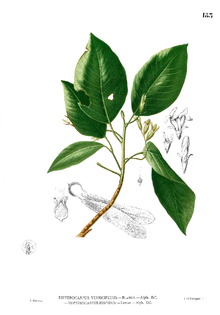| This article needs additional citations for verification. Please help improve this article by adding citations to reliable sources. Unsourced material may be challenged and removed. Find sources: "Dipterocarpus gracilis" – news · newspapers · books · scholar · JSTOR (August 2023) (Learn how and when to remove this message) |
| Dipterocarpus gracilis | |
|---|---|

| |
| Conservation status | |
 Vulnerable (IUCN 3.1) | |
| Scientific classification | |
| Kingdom: | Plantae |
| Clade: | Tracheophytes |
| Clade: | Angiosperms |
| Clade: | Eudicots |
| Clade: | Rosids |
| Order: | Malvales |
| Family: | Dipterocarpaceae |
| Genus: | Dipterocarpus |
| Species: | D. gracilis |
| Binomial name | |
| Dipterocarpus gracilis Blume | |
| Synonyms | |
| |

Dipterocarpus gracilis (Tagalog: panao / Indonesia: kaboa aka sancang) is a critically endangered species of tree in the family Dipterocarpaceae, native to South Asia and Southeast Asia.
Distribution and habitat
D. gracilis is native to Bangladesh, Brunei, Cambodia, India (Assam and the Andaman Islands), Indonesia (Kalimantan, Java, and Sumatra), Malaysia (Sarawak, Sabah, and Peninsular Malaysia), Myanmar, the Philippines, Singapore, and Thailand. It grows in lowland evergreen and semi-evergreen forests, in valleys, and on ridges and slopes from sea level up to 900 m (3,000 ft) above sea level. It prefers well-drained soils and often dominates the canopy of the forests it inhabits.
Uses
It is often used as a commercial grade plywood, it is one of the most important sources of keruing timber.
References
- ^ Ly, V.; Nanthavong, K.; Pooma, R.; Luu, H.T.; Nguyen, H.N.; Barstow, M.; Vu, V.D.; Hoang, V.S.; Khou, E.; Newman, M.F. (2017). "Dipterocarpus gracilis". IUCN Red List of Threatened Species. 2017: e.T31315A2804348. doi:10.2305/IUCN.UK.2017-3.RLTS.T31315A2804348.en. Retrieved 11 November 2021.
- "Dipterocarpus gracilis Blume". Plants of the World Online. Royal Botanic Gardens, Kew. Retrieved 12 October 2024.
 Media related to Dipterocarpus gracilis at Wikimedia Commons
Media related to Dipterocarpus gracilis at Wikimedia Commons
This Dipterocarpaceae article is a stub. You can help Misplaced Pages by expanding it. |
- IUCN Red List vulnerable species
- Dipterocarpus
- Vulnerable flora of Asia
- Dipterocarps of Borneo
- Plants described in 1825
- Trees of Bangladesh
- Trees of Cambodia
- Trees of India
- Flora of Indonesia
- Trees of Malaysia
- Trees of Myanmar
- Trees of the Philippines
- Trees of Singapore
- Trees of Thailand
- Flora of the Andaman Islands
- Dipterocarpaceae stubs